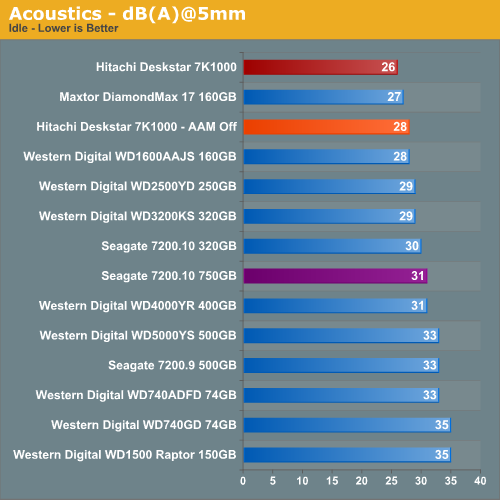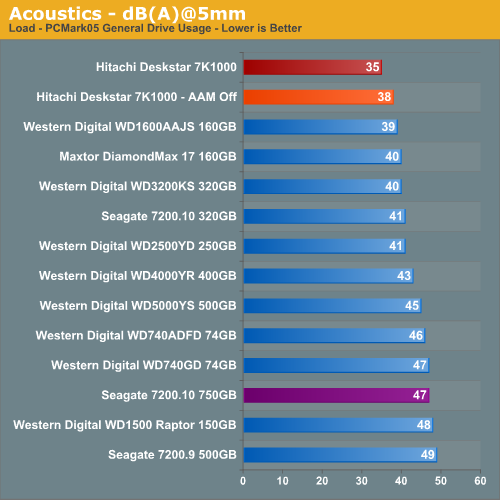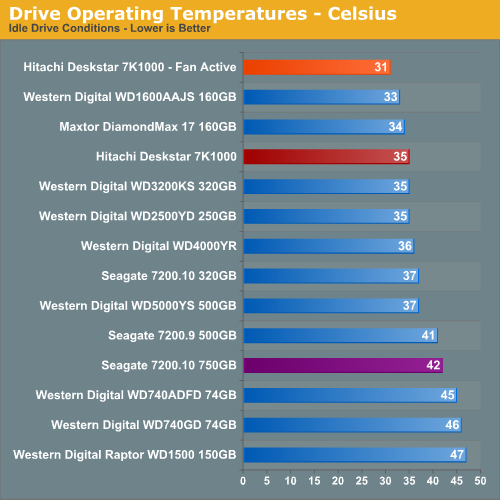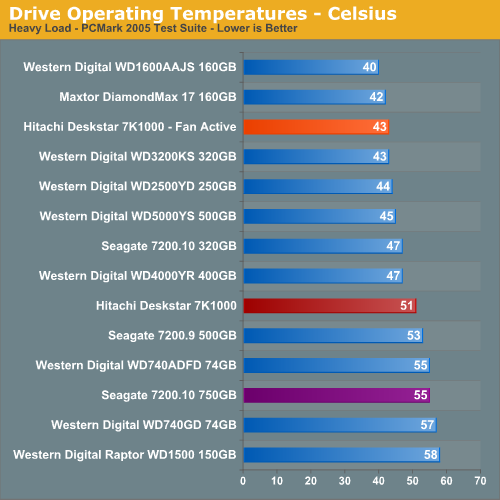Hitachi Deskstar 7K1000: Terabyte Storage arrives on the Desktop
by Gary Key on March 19, 2007 8:00 AM EST- Posted in
- Storage
Hard Drive Performance: Acoustics
Our acoustic test utilizes our standard test bed components but we implement AMD's Cool'n'Quiet technology and turn off the case fans to isolate as much case noise as possible during testing. Our OCZ power supply is nearly silent in these tests and our fanless ASUS 7600GS video card provides a further decrease in our case's ambient noise levels. Our drives are attached to the drive cage with rubber bushings to assist in isolating the noise of the drive without resulting harmonic changes due to the case design
Our acoustic tests are designed to measure the decibel levels while the system is at idle and also under load while running the General Hard Disk Drive Usage benchmark within PCMark 2005. We found through trail and error that this particular benchmark produces controlled readings across a wide range of applications within the benchmark. This particular benchmark utilizes 60% reads and 40% writes within the trace playback file.
The measurements are taken at a distance of 5 millimeters from the rear and front of the drive being tested in order to minimize surrounding environmental noise. We take our measurements over a period of twenty minutes, so idle measurements will include operating system interrupt and polling routines. We have noticed that unless we run a silent system in a near silent room that measurements taken from 1 meter are generally not meaningful due to ambient noise levels. There are exceptions like the Raptor series of drives but overall most modern desktop drives are quieter now than the other components in the system.
The reported measurements are based on an A-weighted decibel score that measures frequencies similar to the way the human ear responds to sound. We take a total of three measurements for each test. We then subtract the high and low scores and arrive at our findings by reporting the remaining score.


Our Hitachi Deskstar 7K1000 is the quietest drive that we have ever tested. We basically could not hear the drive and at times wondered if it was operating with AAM turned on. Even with AAM turned off, the drive was extremely quiet at idle and under load where it still scored better than our other test units. Our subjective opinion with AAM turned off is that the seek requests are muted greatly but still noticeable when compared to the other drives. The only other significant audible noise is a slight whirling sound as the drive spins up on a cold start or after a reboot. We just cannot emphasize enough how quiet this drive is in our test configuration with AAM enabled at the 128 setting. We even removed the rubber mounting grommets in our drive cage and did not notice any differences in acoustics or vibration levels. Our base dB(A) level in the room at time of testing was 25 dB(A).
Hard Drive Performance: Thermals
Our thermal tests utilize sensor readings via the S.M.A.R.T. (Self-Monitoring, Analysis and Reporting Technology) capability of the drives and are reported by utilizing the Active SMART 2.42 utility. We test our drives in an enclosed case environment without the front fan operational to simulate temperatures that could conceivably be reached in a SFF or HTPC case design. We typically find the reported numbers drop anywhere from 18% to 25% on average when the front fan is operational.
We typically let the drive idle for fifteen minutes before starting our idle thermal testing. Our load testing consists of taking the high temperature reading after looping the PCMark 2005 HD Suite benchmark five times. We also check load temps after looping our Nero Recode encoding test three times.


We expected the 7K1000 to run as warm as the Seagate 750GB due to the five platter design. However, under both idle and load conditions it operated significantly cooler than Seagate's large capacity PMR design. We have additional power and thermal management tests to run but at this time we were pleasantly surprised with the results. The load temperatures dropped from 51C to 43C and idle temps dropped from 35C to 31C with our front case fan operational. We highly recommend a fan be installed near the drive during normal operation. Our test room temperatures were 24C during these tests.
Our acoustic test utilizes our standard test bed components but we implement AMD's Cool'n'Quiet technology and turn off the case fans to isolate as much case noise as possible during testing. Our OCZ power supply is nearly silent in these tests and our fanless ASUS 7600GS video card provides a further decrease in our case's ambient noise levels. Our drives are attached to the drive cage with rubber bushings to assist in isolating the noise of the drive without resulting harmonic changes due to the case design
Our acoustic tests are designed to measure the decibel levels while the system is at idle and also under load while running the General Hard Disk Drive Usage benchmark within PCMark 2005. We found through trail and error that this particular benchmark produces controlled readings across a wide range of applications within the benchmark. This particular benchmark utilizes 60% reads and 40% writes within the trace playback file.
The measurements are taken at a distance of 5 millimeters from the rear and front of the drive being tested in order to minimize surrounding environmental noise. We take our measurements over a period of twenty minutes, so idle measurements will include operating system interrupt and polling routines. We have noticed that unless we run a silent system in a near silent room that measurements taken from 1 meter are generally not meaningful due to ambient noise levels. There are exceptions like the Raptor series of drives but overall most modern desktop drives are quieter now than the other components in the system.
The reported measurements are based on an A-weighted decibel score that measures frequencies similar to the way the human ear responds to sound. We take a total of three measurements for each test. We then subtract the high and low scores and arrive at our findings by reporting the remaining score.


Our Hitachi Deskstar 7K1000 is the quietest drive that we have ever tested. We basically could not hear the drive and at times wondered if it was operating with AAM turned on. Even with AAM turned off, the drive was extremely quiet at idle and under load where it still scored better than our other test units. Our subjective opinion with AAM turned off is that the seek requests are muted greatly but still noticeable when compared to the other drives. The only other significant audible noise is a slight whirling sound as the drive spins up on a cold start or after a reboot. We just cannot emphasize enough how quiet this drive is in our test configuration with AAM enabled at the 128 setting. We even removed the rubber mounting grommets in our drive cage and did not notice any differences in acoustics or vibration levels. Our base dB(A) level in the room at time of testing was 25 dB(A).
Hard Drive Performance: Thermals
Our thermal tests utilize sensor readings via the S.M.A.R.T. (Self-Monitoring, Analysis and Reporting Technology) capability of the drives and are reported by utilizing the Active SMART 2.42 utility. We test our drives in an enclosed case environment without the front fan operational to simulate temperatures that could conceivably be reached in a SFF or HTPC case design. We typically find the reported numbers drop anywhere from 18% to 25% on average when the front fan is operational.
We typically let the drive idle for fifteen minutes before starting our idle thermal testing. Our load testing consists of taking the high temperature reading after looping the PCMark 2005 HD Suite benchmark five times. We also check load temps after looping our Nero Recode encoding test three times.


We expected the 7K1000 to run as warm as the Seagate 750GB due to the five platter design. However, under both idle and load conditions it operated significantly cooler than Seagate's large capacity PMR design. We have additional power and thermal management tests to run but at this time we were pleasantly surprised with the results. The load temperatures dropped from 51C to 43C and idle temps dropped from 35C to 31C with our front case fan operational. We highly recommend a fan be installed near the drive during normal operation. Our test room temperatures were 24C during these tests.










74 Comments
View All Comments
mikeg - Thursday, April 26, 2007 - link
Its been a over a month since the article came out and I still don't see any in the retail stores or a non OEM drive. Where can I get one?? Anyone see a retail box of these drives a a retailer? I want to get a coupleMike
jojo4u - Monday, March 26, 2007 - link
Hello Gary,the Hitachi datasheet refers to three idle modes using APM. The results with AAM enabled could suggest that APM is automatically engaged with AAM. So perhaups one should check the APM level with Hitachi's Feature Tool or the generic tools http://hdparm-win32.dyndns.org/hdparm/">hdparm or hddscan.
Gary Key - Friday, March 30, 2007 - link
We had a lengthy meeting with the Hitachi engineers this week to go over APM and AAM modes along with the firmware that is shipping on the Dell drives. I hope to have some answers next week as testing APM capabilities on a Dell based system resulted in a slightly different behavior than our test bench. I have completed the balance of testing with various AAM/NCQ on/off combinations and some additional benchmark tests. I am hoping to update the article next week. Also, I ran acoustic tests in a different manner and will have those results available. Until, then I did find out that sitting a drive on a foam brick outside of a system and taking measurements from the top will mask some of the drives acoustic results. The majority of noise emitted from this drive comes from the bottom, not the top. ;)ddarko - Monday, March 26, 2007 - link
"However, Hitachi has informed us they have the capability to go to 250GB per-platter designs but launched at smaller capacities to ensure their reliability rate targets were met. Considering the absolute importance of data integrity we think this was a wise move."This sounds like an sneaky attempt by Hitachi to raise doubt about the safety of Seagate's forthcoming 1TB drive. Where is the data to support this rather bold statement that 250GB platters designs are not as capable as 200GB designs of meeting these completely unspecified "reliability rate targets"? What does that even mean? Can we infer that 150GB platter designs are even more reliable than 200GB designs? It's disappointing to see the review accept Hitachi's statement without question, going so far as to even applaud Hitachi for its approach without any evidence whatsoever to back it.
Lord Evermore - Thursday, March 22, 2007 - link
While I know memory density in general isn't increasing nearly as fast as hard drive size, 32MB cache seems pretty chintzy for a top-end product. I suppose 16MB on the 750GB drives is even worse.My first 528MB hard drive with a 512KB cache was a 1/1007 ratio (using binary cache size, and labelled drive size which would be around binary 512MB). Other drives still had as little as 128KB cache, so they could have been as little as a 1/4028 ratio, but better with smaller drives. I think anything larger than 512MB always had 512KB.
A 20GB drive with 2MB cache is 1/9536 ratio.
A 100GB drive with 2MB cache is 1/47683.
Then the jump to 8MB cache makes the ratio much better at 1/11920 for a 100GB drive (I'm ignoring the lower-cost models that had higher capacities, but still 2MB cache). Then it gets progressively worse as you get up to the 500GB size drives. Then we make another cache size jump, and the 160GB to 500GB models have a 16MB option, which is back to 1/9536 on a 160GB, to 1/29802 on a 500GB.
The trend here being that we stick with a particular cache size as drive size increases so the ratio gets worse and worse, then we make a cache size jump which improves the ratio and it gets worse again, then we make another cache size jump again.
Now we go to 750GB drives with 16MB cache. Now we are up to a 1/44703 ratio, only the 2nd worse ever, seems like time for another cache increase. Jumping to 32MB with a 100TB drive only makes it 1/29802. Not a very significant change despite doubling the cache again, since the drive size also increased, and it'll only get worse as they increase the drive size. Even 32MB on a 750GB drive is 1/22351, only slightly better than the 16MB/500GB flagship drives when they came out, and we don't even HAVE a 32MB/750GB drive.
A 512MB cache would be nice. That's still not the best ratio ever, it's still 1/1862, but that's a heck of a lot better than 1/30,000th. At the very least, they need to jump those cache chip densities a lot, or use more than one. Even a single 512MB density chip would be 64MB, still not great but better.
Per Hansson - Sunday, March 25, 2007 - link
Bigger caches would almost make it a necessity that you run the system on a UPS.Loosing 32mb of data that is yet to be written to the platters is allot, but 512mb?
And the UPS would not take into account OS crashes...
I'm not sure how much this would affect performance either, but a review of a SCSI drive with a SCSI controller with 2mb - 1gb of cache would answer that question well...
yehuda - Wednesday, March 21, 2007 - link
Do they plan to launch a single platter variant sometime in the near future?Gary Key - Wednesday, March 21, 2007 - link
They will be releasing a 750GB variant in May. Our initial reports have the single platter drives along with the 300~500GB models coming later in the summer. I am trying to get that confirmed now.DeathSniper - Tuesday, March 20, 2007 - link
Last page..."The Achilles heal of the Seagate 750GB drive..."I think it should be heel, not heal ;)
Spacecomber - Tuesday, March 20, 2007 - link
While this drive has enough in the way of other features to make it stand out from the crowd, I was a bit surprised to see that Hitachi hadn't upped the warranty to 5 years for this drive, which is what Seagate offers on most of their drives and WD offers on their raptors.